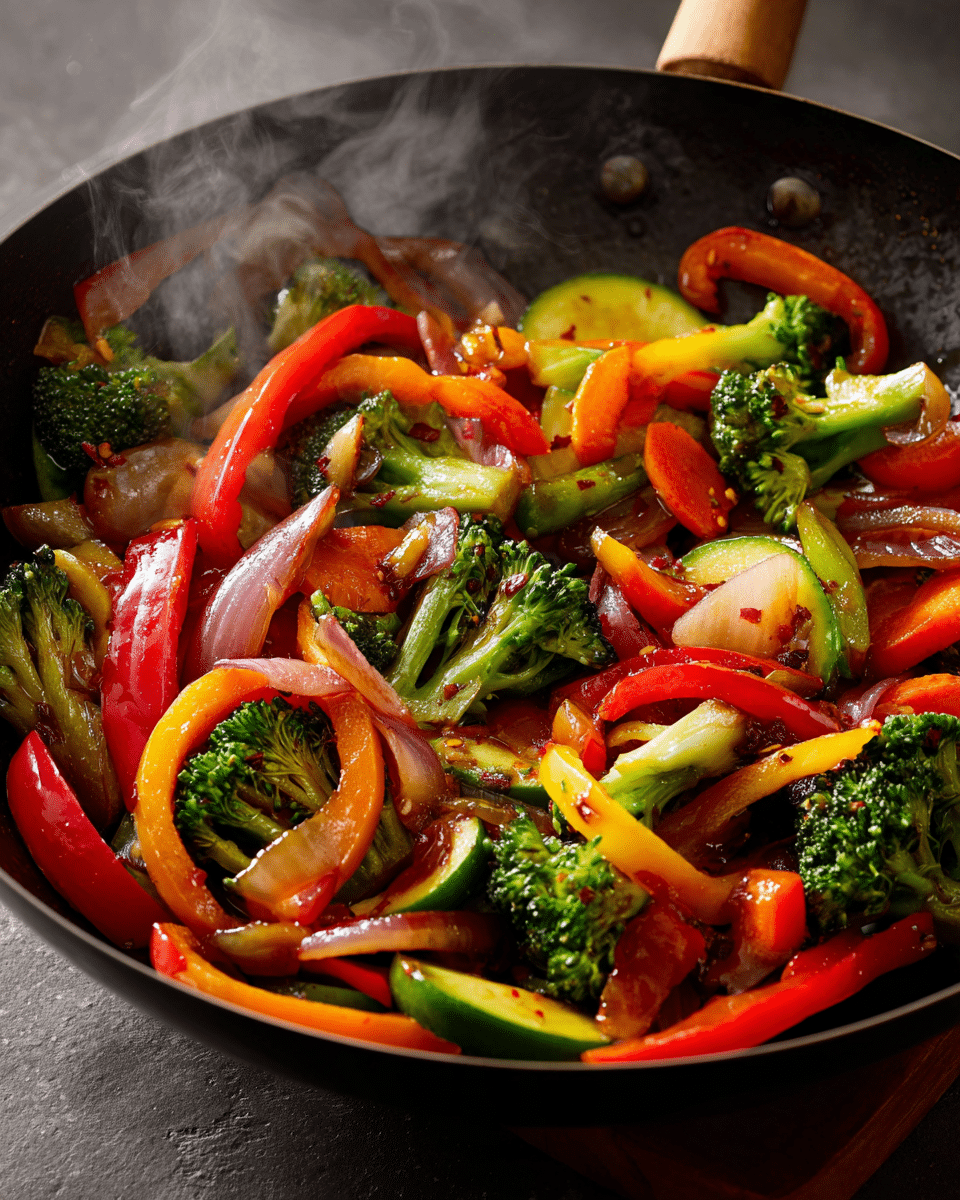This Veggie Stir Fry with Banana Peppers is a vibrant and nutritious dinner option that’s quick to prepare and packed with flavor. Banana peppers add a mild tangy heat that enhances the natural sweetness of stir-fried vegetables. This dish is perfect for busy weeknights or as a satisfying plant-based meal that can be served with rice or noodles.
FULL RECIPE
Ingredients
- 1 tablespoon vegetable oil
- 1 medium onion, sliced
- 2 cloves garlic, minced
- 1 tablespoon fresh ginger, minced
- 1 red bell pepper, sliced
- 1 cup banana peppers, sliced into rings
- 1 medium carrot, julienned
- 1 zucchini, sliced into half moons
- 1 cup broccoli florets
- 2 tablespoons soy sauce
- 1 tablespoon rice vinegar
- 1 teaspoon sesame oil
- 1 teaspoon cornstarch mixed with 2 tablespoons water (optional, for thickening)
- Salt and pepper to taste
- Sesame seeds and chopped green onions for garnish (optional)
- Cooked rice or noodles for serving
Directions
- Heat the vegetable oil in a large skillet or wok over medium-high heat.
- Add the onion and sauté for 2 minutes until slightly softened.
- Stir in the garlic and ginger, cooking for another 30 seconds until fragrant.
- Add the red bell pepper, banana peppers, and carrot. Stir fry for 3–4 minutes.
- Toss in the zucchini and broccoli. Continue stir-frying for another 4–5 minutes until vegetables are crisp-tender.
- In a small bowl, mix the soy sauce, rice vinegar, and sesame oil. Pour over the vegetables and toss to coat evenly.
- If using, add the cornstarch slurry to the pan and stir until the sauce thickens, about 1 minute.
- Season with salt and pepper to taste.
- Remove from heat and garnish with sesame seeds and green onions if desired.
- Serve hot over cooked rice or noodles.
Nutrition Facts
- Calories: 180
- Total Fat: 7g
- Saturated Fat: 1g
- Cholesterol: 0mg
- Sodium: 540mg
- Total Carbohydrates: 25g
- Dietary Fiber: 5g
- Sugars: 9g
- Protein: 5g
- Vitamin A: 110% DV
- Vitamin C: 140% DV
- Calcium: 6% DV
- Iron: 8% DV
Health Benefits of Banana Peppers
Banana peppers are a flavorful and nutritious addition to any stir fry. Low in calories yet rich in vitamins, particularly vitamin C and vitamin A, they support immune health and eye function. These peppers also contain capsaicin, a compound with mild thermogenic effects that may help boost metabolism. Because they’re mild in spice, banana peppers provide flavor without overwhelming heat, making them accessible for a wide range of palates. Their antioxidant content also contributes to reduced inflammation and cellular protection, which aligns perfectly with a health-conscious meal like a veggie stir fry.
Nutrient Density of Stir-Fried Vegetables
Veggie stir fries are excellent examples of nutrient-dense meals, meaning they provide a high concentration of vitamins, minerals, and beneficial plant compounds in relation to their calorie count. This recipe includes a variety of vegetables such as broccoli, bell peppers, carrots, and zucchini—all of which are loaded with fiber, antioxidants, and essential nutrients like potassium and folate. Stir-frying helps retain much of the produce’s original nutritional value, unlike boiling, which can lead to vitamin loss in water. As such, this dish supports digestion, immunity, and overall wellness with every bite.
Flavor Profile and Cooking Technique
The stir-fry technique uses high heat and a small amount of oil to quickly cook vegetables while preserving their color, crunch, and flavor. The banana peppers contribute a tangy, slightly sweet kick, while garlic and ginger infuse the dish with warmth and depth. Soy sauce and sesame oil add umami richness, balancing out the brightness of the vegetables. The quick-cooking method ensures that each component maintains its identity while contributing to a harmonious whole, creating a satisfying combination of textures and tastes with every mouthful.
Meal Prep and Storage Tips
Veggie stir fry with banana peppers is ideal for meal prepping. Once cooked and cooled, it can be stored in an airtight container in the refrigerator for up to four days. To reheat, simply toss it back in a pan over medium heat or microwave in short intervals until warm. If you plan to make it ahead of time, consider undercooking the vegetables slightly so they remain crisp when reheated. It also freezes well, although some delicate vegetables like zucchini may lose their texture. For best results, freeze in single-serving portions for convenient future meals.
Customization and Variations
One of the best things about this stir fry is its flexibility. You can easily adapt it to suit different dietary needs or preferences. For added protein, toss in tofu, chickpeas, tempeh, or a scrambled egg. If you’re not vegetarian or vegan, sliced chicken breast or shrimp make great additions. You can switch up the vegetable mix depending on the season or what’s available in your fridge—try snap peas, mushrooms, cabbage, or baby corn. Even the sauce can be modified by adding hoisin, chili paste, or a splash of lime juice for a different flavor profile.
Cultural Influence and Fusion Potential
Stir frying is a traditional Chinese cooking technique, but this recipe blends it with globally inspired ingredients like banana peppers, which are more commonly used in Mediterranean and American cuisine. The result is a dish that bridges cultures while remaining simple and approachable. The fusion nature of this meal allows for creative reinterpretations—consider adding a Mexican flair with cumin and black beans, or go Thai-style by incorporating coconut milk and Thai basil. This flexibility makes the dish culturally versatile and appealing to a wide audience.
Serving Suggestions and Presentation Tips
Serve the veggie stir fry over a bed of steamed jasmine rice, brown rice, or noodles for a satisfying main course. For a low-carb option, cauliflower rice or spiralized zucchini are great alternatives. Presentation-wise, a sprinkle of sesame seeds or chopped green onions adds color and texture. Serve in a wide, shallow bowl to show off the vibrant vegetables, and consider pairing it with a wedge of lime on the side for a burst of acidity. These small touches elevate the visual appeal and dining experience, making it suitable for casual dinners or even small gatherings.
Pairings and Complementary Dishes
This stir fry pairs wonderfully with other Asian-inspired sides like vegetable spring rolls, dumplings, or miso soup. For drinks, green tea or a light ginger-infused beverage complements the fresh and zesty flavors. If you’re serving it as part of a larger meal, a simple cucumber salad or edamame appetizer can round out the meal with contrasting textures. If you’re including protein, grilled tofu skewers or teriyaki chicken would complement the stir fry without overpowering its mild spice and savory notes.
Sustainability and Ingredient Sourcing
Choosing locally grown, in-season vegetables for this stir fry not only enhances flavor but also supports sustainable food practices. Banana peppers, bell peppers, and zucchini are often available at local markets, and buying them reduces the carbon footprint associated with long-distance transport. Opting for organic or pesticide-free produce also benefits both the environment and your health. This dish exemplifies how thoughtful sourcing and plant-based eating can promote sustainability without sacrificing taste or convenience.
Advertisement
Appeal to Various Diets and Lifestyles
This recipe is naturally vegetarian and can easily be made vegan, gluten-free, and dairy-free. To make it gluten-free, simply substitute tamari or coconut aminos for the soy sauce. It’s ideal for people following plant-based, clean eating, or low-calorie diets, and it fits into many wellness-focused lifestyles. Because it’s free from common allergens like nuts and dairy, it can also be enjoyed by those with specific dietary restrictions. The inclusive nature of this stir fry makes it a practical recipe for households with diverse dietary needs.
Conclusion
Veggie Stir Fry with Banana Peppers is more than just a quick and flavorful dinner—it’s a versatile, nutritious, and culturally flexible dish that caters to a wide range of dietary needs and culinary preferences. With its nutrient-dense ingredients, bold yet balanced flavors, and customizable nature, this stir fry stands out as a healthy go-to recipe for busy weeknights, family meals, or even meal prepping.






